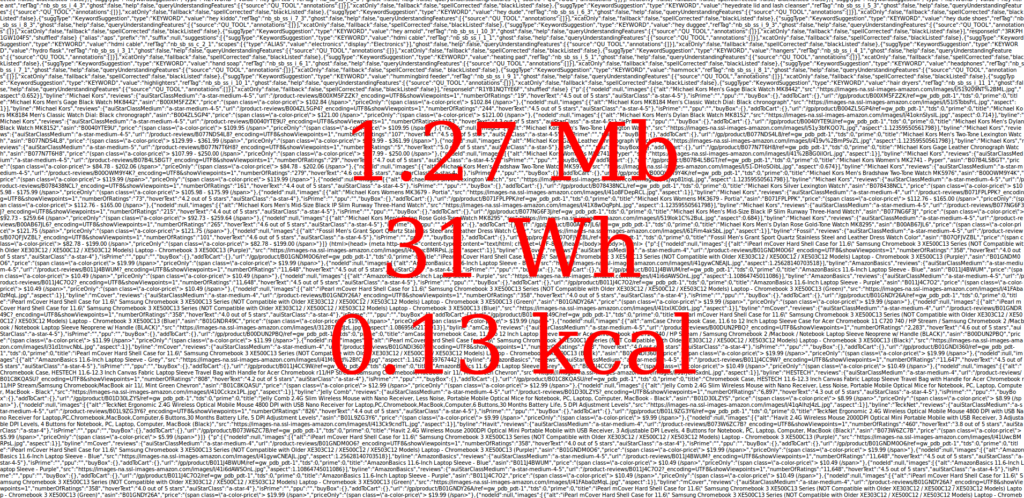
Editor’s note: For the last decade, Joana Moll has exposed the environmental impact of the internet through her art and research. The Hidden Life of an Amazon User was originally published on Joana’s website and invites us to look critically at online interfaces that obscure their true computational cost.
*Each visit emits an estimated amount of 50gr of CO2
On June 17th, 2019 in Utrecht, The Netherlands, I purchased The Life, Lessons & Rules for Success: The Journey, The Teachable Moments & 10 Rules for Success Cultivated from the Life & Wisdom of Jeff Bezos from Amazon’s official website. The web browser used to place this order was Firefox Quantum 67.0.4, installed on a Dell XPS 13 computer that used the operating system Ubuntu 18.04.2.
In order to purchase the book, the Amazon website forces the customer to go through twelve different interfaces composed of large amounts of code, which is normally invisible to the average user. This code carries out all sorts of operations, such as organizing and styling the site’s content, allowing interactivity, and recording the user’s activity. Overall, I was able to track 1,307 different requests to all sorts of scripts and documents, totaling 8,724 A4 pages worth of printed code, adding up to 87.33MB of information. The amount of energy needed to load each of the twelve web interfaces, along with each one’s endless fragments of code, was approximately 30 wh.
According to their own promotional materials, Amazon’s business model is based on “obsessive customer focus,” which entails “constantly listening to customers to enhance and improve the customer experience.” In other words, their business relies on continuously tracking and recording their customers’ behavior and activity in order to amplify the monetization of each user and ultimately to increase Amazon’s revenue.
Thus, the 8,724 pages of code that track and personalize user behavior and experience and were involuntarily loaded by the customer (me) through the browser, are evidence of Amazon’s core money-making strategy at work. Moreover, all the energy needed to load this relatively large amount of information was effectively unloaded on the customer (me), who ultimately assumed not just part of the economic cost of Amazon’s hidden monetization processes, but also a portion of its environmental footprint.
The Hidden Life of an Amazon User aims to shed light on Amazon’s often unacknowledged but aggressive exploitation of their users, which is embedded at the core of the so-called internet companies’ business strategies. Such strategies rely on apparently neutral, personalized user experiences afforded by attractive interfaces. These interfaces obfuscate sophisticated business models embedded in endless pages of indecipherable code, all of which are activated by user labor. In turn, these strategies have a significant energy cost, part of which is involuntarily assumed by the user. To put it bluntly, the user is not just exploited by means of their free labor, but is also forced to assume the energy costs of such exploitation.
This project narrates the journey I undertook inside the intricate labyrinth of interfaces and code that make the purchase of Jeff Bezos’s book possible. Thus, the project allows the user to navigate through the twelve different interfaces that participate in such processes, and explore the vast amount of code that was hidden “behind” them, while witnessing the mounting energy costs that are inadvertently paid for by every Amazon customer.

Further reading on the project
Working for Systems that Do Not Do the Work
Jussi Parikka
The Courier Bag Praxis of Friction
Jara Rocha
a.username? – Plotted by Amazon.com
Christian Ulrik Andersen & Søren Bro Pold
Joana Moll is a Barcelona/Berlin based artist and researcher. Her main research topics include Internet materiality, surveillance, social profiling and interfaces. She is the co-founder of the Critical Interface Politics Research Group at HANGAR in Barcelona, co-founder of The Institute for the Advancement of Popular Automatisms and a visiting lecturer at Universität Potsdam and Escola Superior d’Art de Vic in Barcelona.
